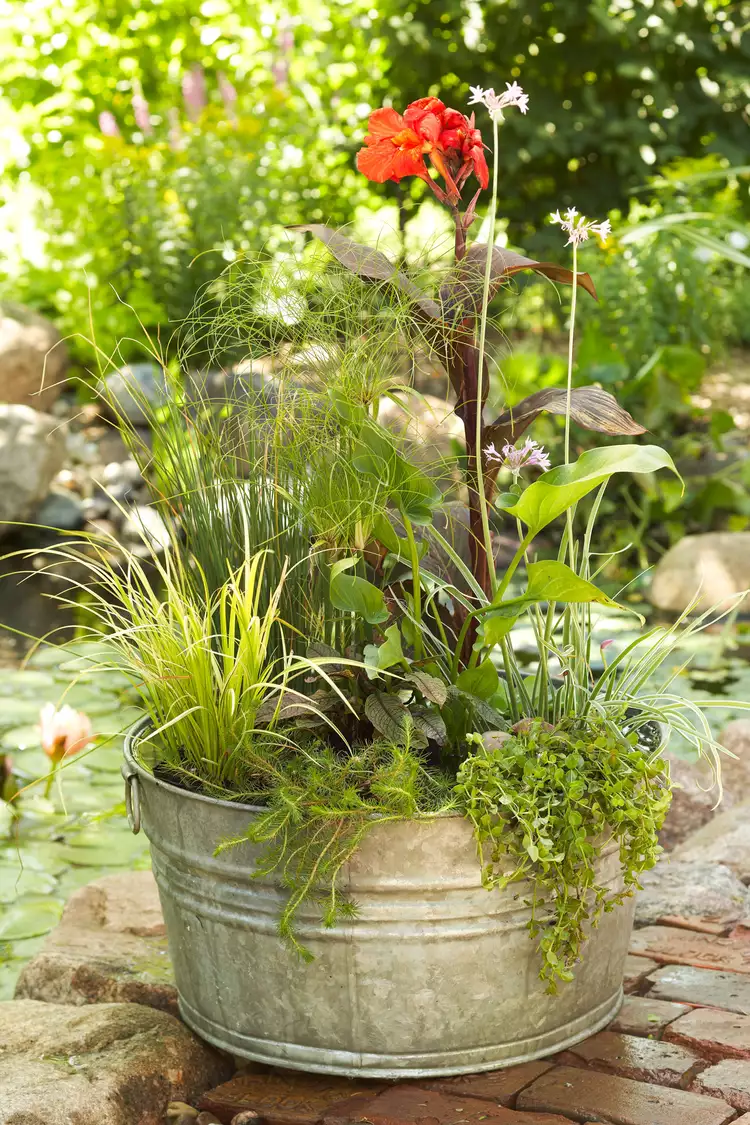Give water gardening a try even if you're short on time and space. Set up a mini aquascape in a container in only an hour or two, with no digging and little expense. Perfect for a patio, deck, or balcony, a potted water garden adds instant appeal: the natural beauty of water-loving plants and the refreshing sparkle of water on a small scale.
Enjoy the assets year-round in a mild climate. Where winters are frosty, savor your little garden throughout the growing season, then bring the plants indoors. Or consign them to compost before cold weather arrives; empty, clean, and store the container for next year's garden.
How to Create an Easy-Care Water Container Garden
What you'll need:
- Galvanized tub or other watertight container
- Several bricks
- Aquatic plants
- Water
- Rocks
Plant list:
- Pickerel weed (Pontederia cordata)
- Canna (Canna spp.)
- Variegated society garlic (Tulbaghia violacea)
- Creeping Jenny (Lysimachia spp.)
- Parrot's feather (Myriophyllum aquaticum)
- Red-veined sorrel (Rumex spp.)
- Sweet flag (Acorus calamus)
- Dwarf cattail (Typha spp.)
- Umbrellagrass (Cyperus spp.)
Step 1
Start with a galvanized tub or other watertight container such as a metal bucket, resin tub, or ceramic pot. If it holds water—or is made to hold water by adding a plastic liner or marine sealant—it can become a water garden. Choose a vessel at least 6 inches deep for best results. Add no more than three plants if the container's diameter is 18 inches or less.
Step 2
Pick a sunny location for your potted water garden. Small tabletop container water gardens prove as portable as deck furniture, but larger gardens such as this one are harder to move after they're planted and filled. When you find an ideal place for your garden, place bricks in the bottom of the container to act as risers for the potted plants.
Step 3
Design your garden. First select from different kinds of water-loving plants widely available at garden centers and nurseries. Some plants prefer to have wet feet; others like to float. Use an odd number of plants (three, five, or seven) for the most pleasing effect. Our scheme includes nine plants in our 24-inch-diameter container. Group fewer plants, if you prefer, leaving more growing room. Arrange the potted plants on the bricks for height.
Step 4
Fill the container with water, covering the rims of the pots. Municipal water is just fine for water gardens that contain only plants, but water drawn from a water softener contains salts that can damage plants. Collected rainwater is a good option. Refill the container periodically as the water evaporates. Prevent mosquitoes by using a tablet for biological control.
Step 5
Top the soil of your potted plants with river rock to help hold the plantings in place. The rock will also give your water garden a more naturalistic appearance. What's more, small stones provide landing pads for birds, butterflies, and other wildlife when they drop by for a drink.
Step 6
Include a floating plant such as water lettuce, which will grow on the water's surface. Water lettuce grows and colonizes quickly, filling in between other plants. If water lettuce becomes too pushy, lift out excess plants and compost them.
Also Try:
1. Small Wonder
When a hardy miniature waterlily such as Nymphaea pygmaea 'Helvola' takes up residence in a glazed ceramic bowl, it can live for years given plenty of sun and winter protection. Check the bowl's water level weekly and top it off as needed.
2. Pint-size Pond
The shiny leaves and delicate blossoms of water hyacinth (Eichhornia crassipes) star in an enamelware container. The plant multiplies quickly, so compost unwanted plants or give them to friends instead of introducing the nonnatives to waterways.
3. Simple Centerpiece
Fitting as a tabletop display, a resin bowl holds leafy rosettes of water lettuce (Pistia stratiotes) and white water snowflake (Nymphoides indica). The floating plants dangle their roots in the water without any need for soil.




















